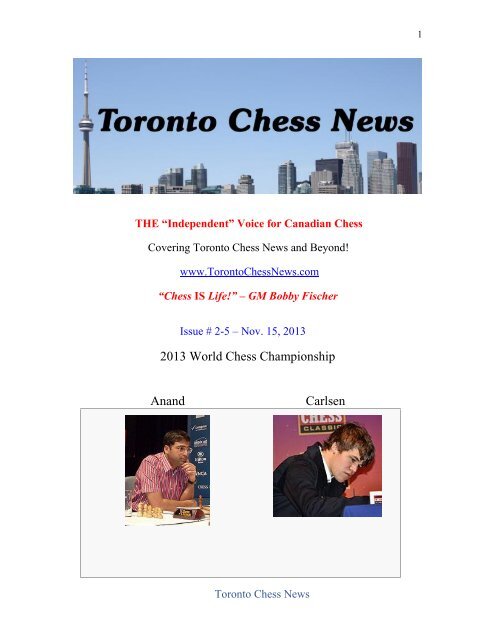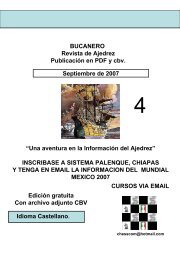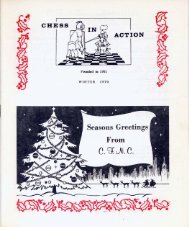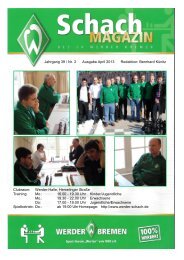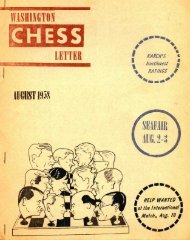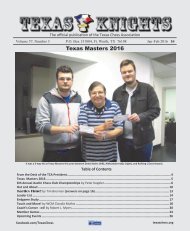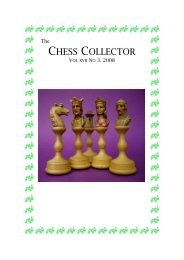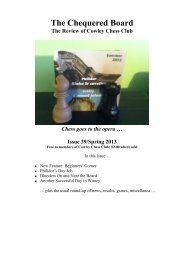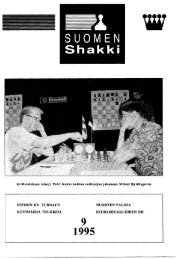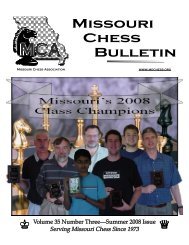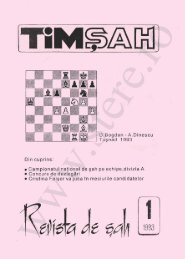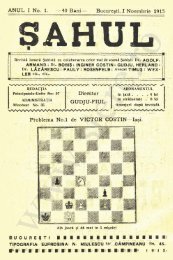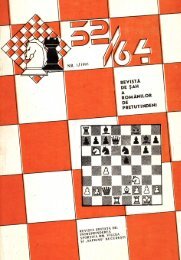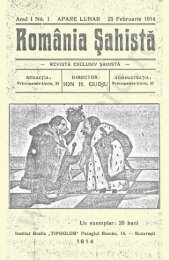Toronto Chess News
El ajedrez es un juego, considerado un deporte, entre dos personas, cada una de las cuales dispone de 16 piezas móviles que se colocan sobre un tablero dividido en 64 escaques. En su versión de competición está considerado como un deporte.
El ajedrez es un juego, considerado un deporte, entre dos personas, cada una de las cuales dispone de 16 piezas móviles que se colocan sobre un tablero dividido en 64 escaques. En su versión de competición está considerado como un deporte.
Create successful ePaper yourself
Turn your PDF publications into a flip-book with our unique Google optimized e-Paper software.
1<br />
THE “Independent” Voice for Canadian <strong>Chess</strong><br />
Covering <strong>Toronto</strong> <strong>Chess</strong> <strong>News</strong> and Beyond!<br />
www.<strong>Toronto</strong><strong>Chess</strong><strong>News</strong>.com<br />
“<strong>Chess</strong> IS Life!” – GM Bobby Fischer<br />
Issue # 2-5 – Nov. 15, 2013<br />
2013 World <strong>Chess</strong> Championship<br />
Anand<br />
Carlsen<br />
<strong>Toronto</strong> <strong>Chess</strong> <strong>News</strong>
2<br />
Articles, etc.<br />
<strong>Toronto</strong> <strong>Chess</strong> <strong>News</strong><br />
Table of Contents<br />
Page<br />
Tournament <strong>Chess</strong>: Playing Up 5<br />
Interesting Canadian <strong>Chess</strong> Personalities – Vlad Drkulec 17<br />
Teaching Classic Games of <strong>Chess</strong> - In and Out of the Outpost 42<br />
Ken’s <strong>Chess</strong> Trivia 47<br />
Malmsten’s <strong>Chess</strong> Pictures 51<br />
TCN Readers’ <strong>Chess</strong> “Sightings” 51<br />
TCN Readers Have Questions 51<br />
TCN Readers’ Feedback 51<br />
TCN’s “Readers’ Opinion” Column 52<br />
Tournament Reports<br />
2013 World <strong>Chess</strong> Championship, India 6<br />
50 Years of <strong>Toronto</strong> Rapid <strong>Chess</strong> Tournament 22<br />
Guelph Fall Pro-Am 32<br />
University of Waterloo Simul 37<br />
Prince Edward Island <strong>Chess</strong> Championship 41<br />
Organizations with <strong>News</strong> Reports<br />
<strong>Chess</strong> Federation of Canada (CFC) 17<br />
Greater <strong>Toronto</strong> <strong>Chess</strong> League (GTCL) 26<br />
Annex <strong>Chess</strong> Club (ACC) 28<br />
Willowdale <strong>Chess</strong> Club (WCC) 30<br />
Aurora <strong>Chess</strong> Club 31<br />
Hamilton City <strong>Chess</strong> Club 39<br />
Kitchener-Waterloo <strong>Chess</strong> Club 40<br />
Tournament Notices<br />
Campbellville Open 52<br />
CYCC Qualifier – <strong>Toronto</strong> 53<br />
Hart House Holidays Open 54<br />
Greater <strong>Toronto</strong> <strong>Chess</strong> League 2014 55<br />
Community Bulletin Board 57<br />
<strong>Toronto</strong> <strong>Chess</strong> <strong>News</strong>
3<br />
NOTES re GAME ANALYSIS<br />
1. I now use Fritz 13#2 in my game analysis, a new version of my old engine. It<br />
asserts that on the opening moves 1.e4 and 1.d4, White immediately gets a<br />
“slight” advantage. It quantifies this advantage as:<br />
1. 1.e4 +/= – 0.58<br />
2. 1.d4 +/= – 0.32<br />
(=: - 0.30 to 0.30; +/=: 0.31 to 0.70)<br />
My prior engine, Fritz 13#1 also held this – a “slight” advantage.<br />
But the new engine asserts, however, for 1.Nf3 that the position is equal.<br />
Fritz13#1 evaluated 1.Nf3 as a “slight” advantage to White. In this conflict, I will<br />
go with my current engine, and treat it as equal.<br />
Historically, these positions 1.e4 and 1.d4 were generally considered equal by<br />
humans. Many still dispute this “slight advantage” evaluation. I am at this point<br />
unsure how many chess engines also object. Though W has "initiative",<br />
some/many (?) feel Bl., with the best move 1 for it, equalizes. However, as I<br />
understand the underlying philosophy of chess, if W has a “slight” advantage,<br />
then Bl. never can equalize, as long as W does not make a mistake (a general<br />
operational principle). So if W starts with a “slight” advantage, and both play<br />
perfect moves, then the status quo should logically prevail to the end.<br />
However, there is one factor that may challenge the computer’s initial assertion of<br />
W advantage at move 1 in these two cases. That is the "horizon effect" limitation<br />
on computers. Computers only “see” so far. As they go deeper into a position and<br />
game, they may then see future positions that require them to change their initial<br />
analysis. It MAY be that when the "perfect game" is taken far enough by the<br />
strongest chess computer in the world, the engine will yet establish equality for<br />
Black. But, ‘til then, I am accepting “slight” advantage for these two of the 20<br />
possible opening moves.<br />
This general explanation is preferable to the annotation being in move 1 in every<br />
game starting with these two moves (which is most of them). I am using this<br />
format of a general explanation after the table of contents to explain this<br />
interesting computer phenomenon (and not insert it into the actual annotated<br />
game). In the game score, I will just note the symbolic and numerical evaluation<br />
by Fritz on these first moves. I hope this small change improves the quality of<br />
TCN for all subscribers.<br />
2. Here are the valuation signs I use in doing annotations:<br />
Slight Advantage to White: +/=<br />
Slight Advantage to Black: =/+<br />
Clear Advantage to White: +/-<br />
Clear Advantage to Black: -/+<br />
<strong>Toronto</strong> <strong>Chess</strong> <strong>News</strong>
4<br />
Winning Advantage to White: +-<br />
Winning Advantage to Black: -+<br />
?! A dubious move - not terrible, but does shift the advantage somewhat toward the<br />
opponent – e.g. where the position is =, and W's move changes it to =/+ (slight advantage<br />
to Black).<br />
? A mistake - this shifts the valuation 2 degrees – e.g. the position is =, and W's move<br />
shifts it to -/+ (clear advantage to Bl.). The move is bad because it not only shifts the<br />
advantage to white a bit, as in where it might give Bl. only a "slight" advantage, but shifts<br />
it all the way to "clear" advantage to Black. Similarly if the position was =/+ (slight<br />
advantage to Black), and Black's move shifted the valuation all the way to =/+ (slight<br />
advantage to White). Again the move didn't just shift the position 1 degree to =, but<br />
actually ended up giving W a "slight" advantage (a movement of what I call 2 degrees of<br />
valuation).<br />
?? - a blunder - a really bad obvious mistake, like hanging a piece, or moving into mate.<br />
! - a good move in the sense that it is somewhat surprising, not immediately obvious that<br />
it is good. For example, when someone sacks a lesser piece, in order a move or two later,<br />
to win a more valuable piece.<br />
!! - a really good move that is not at all obvious, and that you can't immediately see why<br />
it is good. Often an amazing sacrifice of some kind.<br />
!? – an interesting move, but perhaps not quite sound<br />
Hope this helps you to get through my Fritz analysis. These are terms that Fritz<br />
and textbooks do use, but I have sort of created my own unique way of using them with<br />
the computer. I have called my new system, The Comprehensive Annotation System<br />
(CAS). Generally people have found it a very user-friendly system, easy to follow the<br />
shifts in the play as the game unfolds. It is much more detailed in some ways than chess<br />
book writers usually annotate, but the feedback I have gotten is that it is not off-putting.<br />
Once people are used to it, they don't find it a lot of work to follow the annotations.<br />
<strong>Toronto</strong> <strong>Chess</strong> <strong>News</strong>
5<br />
Tournament <strong>Chess</strong>: Playing Up<br />
1 st Principle: Playing Stronger Players<br />
It is commonly said that one improves most from experience, if one plays stronger<br />
players. Generally we work harder, and concentrate more, where we feel the challenge to<br />
us is substantial. And one often hears players giving the opinion that they actually play<br />
better chess against a stronger player, even though they may eventually lose.<br />
2 nd Principle: Playing Weaker Players<br />
Conversely, it is felt that playing weaker players can actually hurt your game to<br />
some extent. The reason is that when you play weak moves, the opponent may not be<br />
skilled enough to punish for it. So you, in a sense, are lulled into a sense of security, that<br />
the line of play is good, when in fact it is inferior. So you may have bad habits reinforced.<br />
As well, a stronger player, because of the rating differential, may consciously, or<br />
unconsciously, work less hard, being somewhat over-confident of an easy win.<br />
The “Playing Up” Option<br />
Many tournaments therefore allow for these principles to operate. In swiss<br />
weekend tournaments, and in most club tournaments, “playing up” is allowed. Usually<br />
the limitation is that the player must have a rating within 100 points of the floor of the<br />
next section up. In clubs, this is generally a free option. But in more and more weekend<br />
tournaments, a “playing up” fee is charged. And in some tournaments now, the organizers<br />
have no rating limitation, but you pay for each section you are wanting to play up.<br />
Sometimes the fee is on a sliding scale – it gets higher for every subsequent section you<br />
want to jump up.<br />
Many lower-rated players are satisfied to only play opponents within a 200 point<br />
range, up or down, and just stay in their section. But a significant minority will be found<br />
playing up, and paying the fee in many tournaments. They want to play stronger<br />
opponents.<br />
What About the Stronger Players?<br />
I have found that the response to playing up among stronger players is quite<br />
varied.<br />
One group seems quite fine with the system, as long as the weaker player is<br />
contributing more to the prize fund of the section, by paying the “playing up fee”. Many<br />
of these feel that a player only 100 points below the floor of the section, will be good<br />
enough to provide a decent game. But even these players tend to object where there is no<br />
rating limitation to playing up, and opponents appear who may be 700 or more points<br />
below them. Though the stronger player will get a win and a point, they feel a fee does<br />
not compensate them sufficiently for the time spent on a game that is not challenging, and<br />
that often finishes early.<br />
<strong>Toronto</strong> <strong>Chess</strong> <strong>News</strong>
6<br />
A second group does not really want organizers to allow “playing up”, even with<br />
the 100 point limit. They are concerned about the second principle elaborated above – the<br />
detriment of playing weaker players. Many of them find the normal sections already<br />
allow quite a rating spread – for example, an U 2000 section will often go down to 1600<br />
– a 400 point rating spread. This group thinks this spread is wide enough. Players a<br />
further 100 points down just dilute the playing strength of the section, and having them<br />
pay a “playing up fee” is not sufficient compensation for this detriment.<br />
What Do You Think?<br />
Do you think playing up should be allowed at all?<br />
If you do, what limitations do you think should be imposed to exert some control<br />
over the option?<br />
Send us your opinions and we’ll publish them under our “Readers’ Opinion”<br />
section. Let us know if you are an elite player or a “class” player. If you favour playing<br />
up, let us know if you do avail yourself of the option when available.<br />
Invitation:<br />
TCN encourages freelancers to submit topical chess articles for our lead article.<br />
Send on your article and we’ll review it with you, with a view to using it (we may<br />
suggest some editing, but generally very minor). You will get full credit in the<br />
publication. We will also post a bit of personal information on the freelancer, if they are<br />
agreeable.<br />
INTERNATIONAL<br />
Tournaments<br />
World <strong>Chess</strong> Championship – Anand vs Carlsen<br />
Defending champion<br />
Challenger<br />
<strong>Toronto</strong> <strong>Chess</strong> <strong>News</strong>
7<br />
Viswanathan Anand (IND)<br />
Magnus Carlsen (NOR)<br />
Born 11 December 1969<br />
44 years old<br />
Born 30 November 1990<br />
22 years old<br />
Winner of the 2012 World <strong>Chess</strong><br />
Championship<br />
Winner of the 2013 Candidates Tournament<br />
Rating: 2775 (World No. 8) [1] Rating: 2870 (World No. 1) [1]<br />
The World <strong>Chess</strong> Championship 2013 is a match between the World <strong>Chess</strong><br />
Champion Viswanathan Anand (winner of the World <strong>Chess</strong> Championship 2012) and<br />
Magnus Carlsen (winner of the 2013 Candidates Tournament), to determine the 2013<br />
World <strong>Chess</strong> Champion. It is being held under the auspices of FIDE, the World <strong>Chess</strong><br />
Federation, from Nov. 6 (Rd. 1 was on Nov. 9) to November 26, 2013 in Chennai, India.<br />
(from Wikipedia)<br />
The official website is: http://chennai2013.fide.com/ .<br />
Here are the results of previous encounters:<br />
Head-to-head record [14]<br />
Anand wins Draw Carlsen wins Total<br />
Anand (white) 2 11 0 13<br />
Classical Carlsen (white) 4 9 3 16<br />
Total 6 20 3 29<br />
Blitz/rapid/exhibition 9 16 8 33<br />
Total 15 36 11 62<br />
The colourful opening ceremony took place in the Jawaharlal Nehru Indoor<br />
Stadium on Thursday, Nov. 7, and had presentations of both Norwegian and Indian<br />
culture.<br />
<strong>Toronto</strong> <strong>Chess</strong> <strong>News</strong>
8<br />
It was in front of a capacity 8000 audience of chess fans!<br />
At the drawing of colours, Anand got Black for Game 1 on Saturday, Nov. 9. At<br />
the WCC Opening Press Conference, World Champion Viswanathan Anand introduced<br />
<strong>Toronto</strong> <strong>Chess</strong> <strong>News</strong>
9<br />
his seconds: Grandmasters Leko, Wojtaszek, Sasikiran, and Sandipan. The challenger,<br />
Magnus Carlsen, thanked Vishy for revealing that, but refused to follow the suit, and did<br />
not name his seconds.<br />
The players are fighting for a purse of $3 million with the winner standing to earn<br />
$1.45m and the loser just under $1m. Carlsen has already pocketed $137,000 of the prize<br />
fund for agreeing to play on his opponent’s home turf. The time control for the 12 games<br />
will be: 40 moves in two hours for each player, the next 20 moves in one hour and 15<br />
minutes for the rest of the game, with an increment of 30 seconds per move starting after<br />
move 61.<br />
At the time of going to press, 4 games have been played. The score is:<br />
Anand 2 – 2 Carlsen<br />
Game 1:<br />
- a rather tame draw. Here it is (Annotations by Bob Armstrong, using Fritz):<br />
Carlsen, Magnus (2870) - Anand, Viswanathan (2775) [D78]<br />
World <strong>Chess</strong> Championship 2013 Chennai (1), 09.11.2013<br />
1.Nf3= [0.28 (by reverse projection) The engines I've used are divided on whether this position is<br />
a "slight" advantage to W (0.29 from one engine, Fritz 13#1 - this engine uses 0–0.25 as =; 0.26–<br />
0.70 as +/=) or equal. Other engines and humans seem divided. So I am going with the engine I<br />
am currently using (Fritz 13#2 - it uses 0–0.30 as =; 0.31–70 as +/=). It treats 1.Nf3 as = or 0.28. I<br />
am repeating this note, found at the start of the newsletter, under annotation notes, since this is a<br />
change in my annotation, and I know most will not have read the annotation notes, assuming that<br />
there was nothing new there. I will repeat this note again now in the individual games following, to<br />
help familiarize readers with the change. After this Issue however, I will just use the symbols and<br />
numerics as the annotation of move 1, as I had been 'til now.]<br />
1...d5= [0,28 (verified depth 28)]<br />
[1...Nf6= 0.29 (verified depth 20); 1...Nc6?!² 0.44 (verified depth 20)]<br />
2.g3 [Reti Opening]<br />
2...g6 3.Bg2 Bg7 4.d4 c6 [developing a pawn chain on the diagonal to blunt the effect of the g2B]<br />
5.0–0 Nf6 6.b3 0–0 7.Bb2 Bf5 8.c4 [Apparently, according to <strong>Chess</strong>Base, the opening has<br />
transposed into a Grunfeld Defence (D78); starting the contest to control the centre]<br />
8...Nbd7 9.Nc3?!³ [Fritz is unhappy. It indicates that the pawn exchange needs to happen now.<br />
Then bring out the b1N.]<br />
[9.cxd5 cxd5 10.Nc3 Rc8= (verified depth 23)]<br />
9...dxc4 10.bxc4 Nb6 11.c5 Nc4 12.Bc1 [12.Qb3 Be6 13.Qc2 Qa5³]<br />
12...Nd5?!= [12...Qa5 13.Qb3 Be6³]<br />
<strong>Toronto</strong> <strong>Chess</strong> <strong>News</strong>
10<br />
13.Qb3 [Carlsen was aware of the potential of this move to attract a 3–fold repetition draw. He<br />
was likely also aware that this was his best move at this point, and if it drew, so be it. This is the<br />
first instance of the position.]<br />
[13.Nxd5?! cxd5 14.Bf4 Rc8³]<br />
13...Na5 [13...b5 14.cxb6 Na5=]<br />
14.Qa3?!³ [14.Qb2 b6 15.cxb6 axb6=]<br />
14...Nc4?!= [(verified depth 25) ]<br />
[14...b6 15.Bg5 h6³]<br />
15.Qb3 [the second appearance of the possible 3–fold draw position]<br />
[15.Qa4? loses a P 15...Nxc3 16.Qxc4 Bxd4µ]<br />
15...Na5 [ ]<br />
[15...b5= 16.cxb6 (16.Rd1?! e6³; 16.a4?! Na5³) 16...Na5=]<br />
16.Qa3?!³ [(verified depth 25) Carlsen offers a 3–fold draw; the alternative move is quite playable,<br />
and creates an = valuation, and the game would go on.]<br />
[16.Qb2 b5 17.Nxd5 Qxd5=]<br />
16...Nc4?!= [3–fold repetition draw offer accepted by Vishy, though he too could have played on<br />
in a slightly superior position. The draw was agreed on move 16. A moral victory for Anand, with<br />
the Black pieces. Vishy called the result "satisfactory". Magnus said "no damage done; it is a long<br />
match".]<br />
[16...b6 17.Bg5 h6³]<br />
½–½<br />
Game 2:<br />
- also a quick draw, since both played the opening with lightning speed – both were<br />
apparently very booked on this opening. Here is the game (Annotations by Bob<br />
Armstrong, using Fritz):<br />
<strong>Toronto</strong> <strong>Chess</strong> <strong>News</strong>
11<br />
Anand, Viswanathan (2775) - Carlsen, Magnus (2870) [B19]<br />
WCC 2013 Chennai (2), 10.11.2013<br />
1.e4² [0.46 (by reverse projection)]<br />
1...c6 [0.64 (by reverse projection) Caro-Kann Defence.]<br />
[1...e5² 0.46 (verified depth 25); 1...d5² 0.59 (verified depth 25); 1...g6?!²]<br />
2.d4 [0.64 (by reverse projection)]<br />
[2.Nf3 0.55 (by reverse projection) 2...d5 3.Nc3 (3.e5 c5² 0.46 (verified depth 25)) 3...Nf6² 0.55<br />
(verified depth 25)]<br />
2...d5 [0.64 (verified depth 25)]<br />
3.Nc3 [3.e5 c5 (3...g6?! 4.Nc3 Bg7±) 4.dxc5 (4.Nf3 e6²) 4...e6²]<br />
3...dxe4 4.Nxe4 Bf5 [4...Nf6 5.Nxf6+ 5...exf6²]<br />
5.Ng3 Bg6 6.h4 h6 7.Nf3 [7.Bc4?! Nd7 8.Nh3 (8.h5 Bh7=; 8.Qe2 Ngf6=; 8.N1e2 e6=) 8...Bh7=]<br />
7...e6 8.Ne5 Bh7 9.Bd3 Bxd3 10.Qxd3 Nd7 11.f4 Bb4+ 12.c3?!= [12.Bd2 Bxd2+ 13.Qxd2 Ngf6²<br />
(verified depth 24) (13...Qe7²) ]<br />
12...Be7 13.Bd2 [13.Nh5 Bxh4+ 14.Kd1 Bf6=]<br />
13...Ngf6 14.0–0–0 0–0 15.Ne4 Nxe4 16.Qxe4 Nxe5 17.fxe5 Qd5 18.Qxd5 cxd5 19.h5 b5<br />
20.Rh3 a5 21.Rf1 Rac8 22.Rg3 Kh7 23.Rgf3 Kg8 24.Rg3 Kh7 25.Rgf3 Kg8=<br />
½–½<br />
<strong>Toronto</strong> <strong>Chess</strong> <strong>News</strong>
12<br />
Game 3 (Nov.12):<br />
- a fighting draw that saw Vishy with the upper hand throughout the game, and at<br />
one point being up, temporarily, 2 P’s. Here is the game (Annotations by Bob<br />
Armstrong, using Fritz):<br />
Carlsen, Magnus (2870) - Anand, Viswanathan (2775) [A09]<br />
2013 World <strong>Chess</strong> Championship Chennai (3), 12.11.2013<br />
1.Nf3= 0.28 [ ]<br />
1...d5 2.g3 g6 3.c4 dxc4 [Vishy, at least temporarily, goes up a P]<br />
4.Qa4+ Nc6 5.Bg2 Bg7 6.Nc3 e5 7.Qxc4 [material equality; time to capture or Vishy will protect<br />
with....Be6.]<br />
7...Nge7 8.0–0 0–0 9.d3 h6 [prophylactic - keeping Magnus' N and B off g5]<br />
[9...Be6 10.Qc5 (10.Qh4 Nf5 11.Qxd8 Raxd8 12.Ng5 Bd7=) 10...Nf5=]<br />
10.Bd2 Nd4?!² [(verified depth 20)]<br />
[10...Be6 11.Qa4 Nf5 12.Rac1 a5=]<br />
11.Nxd4 exd4 12.Ne4 c6 13.Bb4?!= [13.Qc1 Nf5 14.a4 Be6²]<br />
13...Be6 14.Qc1 Bd5 15.a4?!³ [15.Bd2 Nf5 16.Qc2 Re8=]<br />
15...b6 [15...a5 16.Ba3 b6³]<br />
16.Bxe7 Qxe7 17.a5 Rab8?!= [17...Rfd8 (depth 23) 18.Re1³ Qb4³ (18...Qe5?!= 19.b4 (verified<br />
depth 22) 19...Qe7= (19...Bf8=) ) ]<br />
18.Re1 Rfc8 19.axb6 axb6 20.Qf4 Rd8 21.h4?!³ [(verified depth 23) Magnus is known for<br />
playing inferior moves, to create dynamics he feels gives him chances to recover and then win. It<br />
is not yet clear if this is always conscious, or rather instinct (without maybe realizing the exact<br />
valuation of the move).]<br />
[21.Nd2 g5 22.Qg4 Be6 23.Qh5 Qb4=]<br />
21...Kh7 22.Nd2 [22.h5 g5 23.Qc1 f5³]<br />
22...Be5 23.Qg4 h5³ [23...Be6³ the first instance of a possible 3–fold repetition 24.Qe4 Bd5<br />
25.Qg4³ (verified depth 23) 25...Be6?!= the second instance, and it would be drawn. Vishy<br />
rejected going for a draw, feeling likely that he had the advantage, which Fritz confirms. (25...h5³)<br />
]<br />
24.Qh3 Be6 25.Qh1 c5 26.Ne4?!µ [Vishy gets a "clear" advantage]<br />
[26.Bc6?! b5 27.Qe4 (27.b3 Rb6µ (27...Kg8?!³; 27...Bg7?!³) ) 27...Qc7µ; 26.b3 b5 27.Ra6 Bg7³]<br />
26...Kg7 27.Ng5 [ ]<br />
[27.Rec1 c4 28.f4 Bf6µ]<br />
<strong>Toronto</strong> <strong>Chess</strong> <strong>News</strong>
13<br />
27...b5 28.e3 [28.Nxe6+ Qxe6 29.Be4 (29.f4 Bf6µ) 29...c4µ]<br />
28...dxe3 29.Rxe3 Bd4?!³ [29...Bxb2 30.Rae1 Rb6µ]<br />
30.Re2?!µ [30.Re4 Qd6 31.Nxe6+ fxe6³]<br />
30...c4 31.Nxe6+ [31.Bf1 cxd3 (31...Rb6?! 32.dxc4 bxc4³) 32.Nxe6+ fxe6 33.Rd2 Qb4µ]<br />
31...fxe6 32.Be4 cxd3 [Vishy goes up a P]<br />
33.Rd2 Qb4 34.Rad1 Bxb2?!³ [Vishy goes up 2 P's]<br />
[34...Rf8 35.Kh2 Bxf2 36.Rxd3 Rf7µ]<br />
35.Qf3 Bf6?!= [35...Bd4 36.Bxd3 Qf8³]<br />
36.Rxd3 [Vishy is up a P]<br />
36...Rxd3 37.Rxd3?µ [37.Bxd3 Qg4 38.Qxg4 hxg4=]<br />
XABCDEFGHY<br />
8-tr-+-+-+(<br />
7+-+-+-mk-'<br />
6-+-+pvlp+&<br />
5+p+-+-+p%<br />
4-wq-+L+-zP$<br />
3+-+R+QzP-#<br />
2-+-+-zP-+"<br />
1+-+-+-mK-!<br />
xabcdefghy<br />
37...Rd8?= [37...Bd4 38.Qe2 Rf8µ]<br />
38.Rxd8 Bxd8 39.Bd3 Qd4 40.Bxb5 [material equality]<br />
40...Qf6?!² [40...Bb6 41.Bc6 Bc5=]<br />
41.Qb7+ Be7 42.Kg2?!= [42.Be2 Kh6 43.Qc6 e5²]<br />
42...g5 43.hxg5 Qxg5 44.Bc4 h4 45.Qc7 hxg3 46.Qxg3 e5 47.Kf3 Qxg3+ 48.fxg3 Bc5 49.Ke4<br />
Bd4 50.Kf5 Bf2 51.Kxe5 Bxg3+=<br />
½–½<br />
<strong>Toronto</strong> <strong>Chess</strong> <strong>News</strong>
14<br />
Game 4: An exciting draw that saw the advantage swing back and forth. It was the<br />
longest game at that point, at 6 hours. Here is the game (Annotations by Bob Armstrong,<br />
using Fritz):<br />
Anand, Viswanathan (2775) - Carlsen, Magnus (2870) [C67]<br />
2013 World <strong>Chess</strong> Championship (4), 13.11.2013<br />
1.e4² [0.58 (by reverse projection) Both engines and humans are somewhat divided on whether<br />
the evaluation of this position is = or +/=. The engine I am using opts for +/=, as did the engine I<br />
used before this. So I will follow my engines' lead, and agree to +/=. It is numerically calculated as<br />
0.58 in this opening. Although logical consistency would demand that 1.e4 be the same valuation<br />
regardless of the defence used, this is not yet totally confirmed by me. It is dependent on time<br />
available for further research.]<br />
[1.d4² 0.32 (by reverse projection) 1...d5² 0.32 (verified depth 25) 2.Nf3² 0.32 (depth 25) (2.c4?!=<br />
0.29 (depth 25)) ]<br />
1...e5 [0.58 (verified depth 25)]<br />
2.Nf3 [2.d4?! exd4 3.Nf3 Nc6 4.Nxd4 Nf6=]<br />
2...Nc6 [2...Nf6 3.Nxe5 d6 4.Nf3 Nxe4²]<br />
3.Bb5 Nf6 4.0–0 [0.33 (verified depth 23)]<br />
4...Nxe4 [(depth 23)]<br />
[4...Bc5² 5.Nxe5 Nxe4 (5...Nxe5 6.d4 a6 7.Be2 Bxd4 8.Qxd4²) 6.Qe2 (6.Qe1 f5 7.Bxc6 dxc6 8.d3<br />
Qe7 9.Nf3 (9.dxe4 Qxe5 10.exf5 Qxe1 11.Rxe1+ Kf7²) 9...Nf6²) 6...Nxe5 7.Qxe4 Qe7²; 4...Bd6<br />
5.d4 Qe7²]<br />
5.d4 [5.Re1?! Nd6 6.Nxe5 (6.Bf1 Be7=) 6...Be7=]<br />
5...Nd6 [5...exd4 6.Re1 d5² (6...f5?!±) ]<br />
6.Bxc6 dxc6 7.dxe5 Nf5 8.Qxd8+ [8.Qe2 Nd4 9.Nxd4 Qxd4²]<br />
8...Kxd8 9.h3 Bd7 10.Rd1 Be7 11.Nc3 Kc8?!± [Vishy gets a "clear" advantage]<br />
[11...Ke8 12.g3 h5²]<br />
12.Bg5 h6 13.Bxe7 Nxe7 14.Rd2?!² [14.a4 c5 15.a5 Bc6±]<br />
14...c5 15.Rad1 Be6 16.Ne1?!= [Vishy has lost his advantage]<br />
[16.Kh2 b6 17.Ne4 Kb7²]<br />
16...Ng6 17.Nd3 [17.Ne4 b6 18.Nf3 Kb7=]<br />
17...b6 18.Ne2?!³ [it appears that this was a deliberate P-sac by Vishy to gain the initiative; but<br />
for the first time in the game, Magnus gets the advantage because of it. It may be an unsound<br />
sac.]<br />
[18.b3 Kb7 19.f4 c4=]<br />
<strong>Toronto</strong> <strong>Chess</strong> <strong>News</strong>
15<br />
18...Bxa2 [Magnus goes up a P]<br />
19.b3 c4 20.Ndc1 cxb3 21.cxb3 Bb1 22.f4 Kb7 23.Nc3 Bf5 24.g4 Bc8 25.Nd3 h5 [25...Ne7<br />
26.Rc1 Be6³]<br />
26.f5 Ne7 [26...Nh4³ 27.Rf2 (27.Rf1 g6³ (27...hxg4 28.hxg4 g6³) ) 27...hxg4 28.hxg4 g6³]<br />
27.Nb5 [27.Re2 Nc6 (27...Rh7?! 28.Ne4 hxg4 29.hxg4 Rh4=) 28.Re4 hxg4 29.hxg4 Rh6³;<br />
27.Re1 hxg4 28.hxg4 Nc6³]<br />
27...hxg4 28.hxg4 Rh4 [28...a6 29.Nd4 a5³]<br />
29.Nf2 Nc6 30.Rc2?!µ [30.Re2³]<br />
30...a5?!³ [30...g6 31.e6 fxe6 32.fxg6 (32.Rdc1 Bd7 33.fxe6 Be8µ) 32...Rh6µ]<br />
31.Rc4?!µ [Magnus gets a "clear" advantage]<br />
[31.e6?!µ fxe6 32.fxe6 Bxe6 33.Rxc6! Kxc6 34.Nd4+ Kd7 35.Nf3+ Kc8 36.Nxh4 Bxb3µ Magnus<br />
would have 3 P's (connected and passed) vs N; 31.Kg2 Rh6 32.Kg3 g6³]<br />
31...g6 32.Rdc1 Bd7 33.e6 [33.fxg6 fxg6 34.e6 Be8 (34...Bxe6?? 35.Rxc6 Bxb3 36.Rxc7+ Ka6+–<br />
) 35.Ne4 Rxg4+ 36.Kf2 Rd8µ]<br />
33...fxe6 34.fxe6 Be8 [34...Bxe6?? 35.Rxc6 Bxb3 36.Rxc7+ Ka6+–]<br />
35.Ne4! [a sound P-sac by Vishy, to get play against the K]<br />
35...Rxg4+ [Magnus goes up 2 P's]<br />
36.Kf2 Rf4+?!³ [36...Rd8 37.Ke3 Rd5µ]<br />
37.Ke3 Rf8?!= [Magnus has lost his advantage, despite being up a P]<br />
[37...g5 38.Rg1 (38.Nd4?! Nb4 39.Rxc7+ Ka6µ) 38...Rh4 39.Rxg5 Rh7³]<br />
XABCDEFGHY<br />
8r+-+ltr-+(<br />
7+kzp-+-+-'<br />
6-zpn+P+p+&<br />
5zpN+-+-+-%<br />
4-+R+N+-+$<br />
3+P+-mK-+-#<br />
2-+-+-+-+"<br />
1+-tR-+-+-!<br />
xabcdefghy<br />
<strong>Toronto</strong> <strong>Chess</strong> <strong>News</strong>
16<br />
38.Nd4! Nxd4 39.Rxc7+ [Magnus is up a P, but can Anand now draw?]<br />
39...Ka6 40.Kxd4 Rd8+= [both players have made the first time control]<br />
41.Kc3?µ [Magnus gets back a "clear" advantage]<br />
[41.Ke3 Rd5 42.Rg7 Rb5=]<br />
41...Rf3+ 42.Kb2 Re3 43.Rc8 [43.e7 Rdd3µ]<br />
43...Rdd3?!³ [ ]<br />
[43...Rxc8 44.Rxc8 Bc6µ]<br />
44.Ra8+?!µ [44.R1c4 Re2+ (44...Rxb3+?! 45.Kc2 Rb4 46.Rxb4 axb4 47.Nd6 Bc6 48.Rxc6 Rxe6<br />
49.Kb3 g5 50.Kxb4 g4= will be drawn) 45.Kc1 Rh3³]<br />
44...Kb7 45.Rxe8 Rxe4 46.e7 Rg3?!³ [46...g5 47.Kc2 Rde3µ]<br />
47.Rc3 Re2+ 48.Rc2 Ree3?!= [48...Re5 49.Rf2 Rge3³]<br />
49.Ka2?µ [49.Rh2 b5 50.Kc2 Kc6=]<br />
49...g5 50.Rd2 Re5 51.Rd7+ Kc6 52.Red8 Rge3 53.Rd6+ Kb7 [(1) 53...Kc5µ 54.e8Q Rxe8<br />
55.Rd5+ Kb4 56.Rd4+ Kb5 57.R4d5+ Ka6 58.Rxe8 Rxe8 59.Rxg5 Re2+ (59...Re7µ) 60.Ka3<br />
Rd2µ; (2) 53...Kb5?= 54.Rb8 Kc5 55.Rbxb6 Rxe7 56.Rbc6+ Kb4 57.Rb6+ Kc5 58.Rbc6+=]<br />
54.R8d7+ Ka6 55.Rd5 Re2+ 56.Ka3 Re6 57.Rd8 g4 58.Rg5 Rxe7 [Magnus goes up 2 P's]<br />
59.Ra8+ Kb7 60.Rag8 a4?= [60...Rd2 61.R8g7 (61.Rxg4 Re5µ) 61...Rxg7 62.Rxg7+ Ka6µ]<br />
61.Rxg4 [61.R8g7= Ka6 62.Rxe7 Rxe7 63.Rxg4 Kb7=]<br />
61...axb3 62.R8g7 Ka6 63.Rxe7 Rxe7 64.Kxb3= [Magnus is up a P, but the game is a<br />
theoretical draw.]<br />
½–½<br />
So the match is now tied: Vishy 2 : 2 Magnus<br />
Remember that Game 5 is today, Friday, Nov. 15. For those in the EST zone, the games<br />
start at 4<br />
<strong>Toronto</strong> <strong>Chess</strong> <strong>News</strong>
17<br />
NATIONAL<br />
Organizations<br />
<strong>Chess</strong> Federation of Canada (CFC)<br />
Website: http://www.chess.ca/<br />
<strong>Chess</strong> Discussion Forum: http://www.chesscanada.info/forum/forumdisplay.php?f=2<br />
(by TCN Liaison for CFC, Bob Armstrong, CFC Public Relations Coordinator)<br />
Canada will be sending a junior team and 4 coaches to the World Youth <strong>Chess</strong><br />
Championships in the United Arab Emirates. It runs from Dec. 18 – 24. It will be 8<br />
rounds. Andrew Giblon will again be head of delegation.<br />
Here is the Team Canada blog page, for up to date info:<br />
http://2013wycc.blogspot.ca/<br />
Profiles<br />
Interesting Canadian <strong>Chess</strong> Personalities<br />
This is a series TCN started in Issue # 1-4, where, from time to time (in the 15 th of<br />
the month Issue), we will introduce Canadian chess personalities, past and present, in<br />
some detail, and, if possible, have them present to our readers their chess profile in their<br />
own words. Alternatively, we may have biographies of them from available public and<br />
private sources.<br />
Prior Personalities presented are: Howard Ridout; Zoltan Sarosy; Harmony Zhu;<br />
Phil Haley, Maurice Smith and Yuanling Yuan.<br />
We are pleased to continue our series with the introduction of<br />
Vlad Drkulec, CFC President<br />
<strong>Toronto</strong> <strong>Chess</strong> <strong>News</strong>
18<br />
I was probably about seven or eight (yes we started late in those days) when my grade<br />
school teacher introduced me to the final element that had eluded me that checkmate was<br />
the object of the game of chess. My father taught me chess as a very young child but I<br />
didn’t become really interested (obsessed) until I went to high school at the grand old age<br />
of 12. My first experience was not very promising when in grade 9 I tried out for the<br />
chess team and lost to a girl in the playoff to decide who would make the team. She<br />
successfully played the four move checkmate on me. This experience certainly gave me<br />
an appreciation right at the beginning of my chess journeys that women could also be<br />
formidable competitors and unfortunately in this case she served as a gatekeeper who<br />
barred my way into the world of organized chess for a year.<br />
My uncles visited from Croatia that year and my dad brought out the chess board and I<br />
became more interested in the idea of improving. The first steps was I took in my chess<br />
evolution were to take down the Encyclopedia Brittanica and read the articles that they<br />
had on chess which traced the historical development of chess and talked about the need<br />
for quick development and the dogmas of various schools of chess. A whole new world<br />
was opened to me. I managed to beat my dad for the first time after my brief study of<br />
chess history. At the same time the Fischer mania was starting to sweep the world and I<br />
followed the match with great interest, going over the games and buying a hastily<br />
assembled book that came out after the match and studying the games in greater depth.<br />
The next year as a veteran of the summer with Bobby Fischer and Boris Spassky and<br />
marathon chess sessions with my uncles and father, when I tried out for the chess team<br />
the sailing was quite a bit smoother. The four move checkmate would no longer succeed<br />
against me. I played on the fourth board and won most of my games. I became close<br />
friends with Mike Petras who was the best player on the team and became immersed in<br />
the very competitive local high school chess scene. Mike got me to go to the Windsor<br />
YMCA chess club where I eventually joined the teams that played in the Detroit Metro<br />
<strong>Chess</strong> League and perhaps more importantly met Milan Vukadinov who was a very<br />
<strong>Toronto</strong> <strong>Chess</strong> <strong>News</strong>
19<br />
strong local player and tireless friend and mentor to a generation of Windsor players.<br />
Milan was and continues to be an inspiration to me.<br />
In the 1970s Milan would hold court along with Ray Stone at the Volcano Pizzeria after<br />
we played in the Detroit Metro <strong>Chess</strong> League and we would all show our games one by<br />
one while Milan and Ray offered suggestions for improvements in our play over the<br />
pizzas, soft drinks and coffee. Windsor had as many as five teams as I recall spread over<br />
the different leagues which were organized to give good games to all involved whether<br />
grandmaster or lowly D player. Les Mohacsy who was the president of the YMCA chess<br />
club used to drive all the kids over to Detroit in his station wagon. Hundreds of people<br />
would play chess one Friday a month in a church hall. I played on the third team which<br />
was the group Milan dubbed the young lions. We started playing in Detroit area<br />
tournaments and winning chess books as prizes and buying and reading chess books<br />
which turned into a bit of an obsession to the point where I now own at least 1300 of<br />
them the last time I counted. Early favourites were Vladimir Vukovich’s book on The<br />
<strong>Chess</strong> Sacrifice and Cafferty’s book on Tal’s 100 best games. I also pored over library<br />
books like Euwe’s, “Road to <strong>Chess</strong> Mastery” and Nimzovitch’s “<strong>Chess</strong> Praxis” and “My<br />
System”. “Think Like A Grandmaster” by Kotov and Tal’s “The Life and Games of<br />
Mikhail Tal” would later become two of my favourite books.<br />
Ray Stone and Milan helped me to become a stronger player in the 1990s when they<br />
recruited me to play on the fourth board of the first Windsor Team in the Detroit Metro<br />
League as a very rusty A player. Being exposed to strong players and their thinking and<br />
analysis was very useful and I still use some of the things that I learned there when I<br />
teach chess now. I quickly became a master in the U.S. and later Canada though I would<br />
be hampered by health problems related to an old back injury which caused my standard<br />
of play to drop considerably in the middle 1990s. It is hard to play chess well when you<br />
are in great deal of physical discomfort and pain. After much physical therapy I was able<br />
to put those back problems largely behind me. They do recur after exercise occasionally<br />
as bouts of arthritic pain but still seem much more manageable than they were then. This<br />
along with some burnout as a chess organizer led me to leave organized chess behind for<br />
about a decade or more. I met John Coleman at a local bookstore in the early 2000s and<br />
told him that I thought that I would never return to chess. I returned in 2007.<br />
I started my chess comeback in 2007 by reading or rereading several chess books in a<br />
period of about two months. I made my way to the Riverside <strong>Chess</strong> Club one Saturday in<br />
2007 for the first time and learned that my friend Jim Daniluk (an alumni of the Windsor<br />
high school league) who lived in Calgary was visiting friends in Windsor had picked that<br />
day to visit the chess club and ask about me. The club members had told him that they<br />
hadn’t seen me in a dozen years and he left. After some searching through online sources<br />
I managed to find him and we did get together for some blitz but it was a rather funny<br />
coincidence.<br />
I have always been good with kids. I have 15 nieces and nephews and so I am somewhat<br />
familiar with their thought process. In the 1980s, I helped coach a girls’ team to a league<br />
softball championship despite not knowing much about baseball beyond the basics. It<br />
<strong>Toronto</strong> <strong>Chess</strong> <strong>News</strong>
20<br />
was a real “Bad <strong>News</strong> Bears” turnaround situation and the psychology of convincing girls<br />
(or boys) that they can win at baseball is not all that different from convincing them that<br />
they can win at chess.<br />
John Coleman who had started a chess class at Sobeys for the best Windsor chess kids<br />
approached me to teach the class for him and I did. John runs the Windsor <strong>Chess</strong><br />
Challenge tournament where as many as 1600 Windsor grade school kids compete.<br />
There is a playoff tournament for the winners of gold and silver medals at the main<br />
tournament. The winners of that tournament are invited to attend the OYCC. The<br />
winners of the Windsor playoff tournament would go on to play in OYCC and lose<br />
miserably to kids from the rest of the province. The Friday Sobeys class was John’s<br />
vehicle to try to change that.<br />
A new instructor with a master’s rating rejuvenated a few of the kids who were on the<br />
verge of quitting chess and they started to make great progress including current CFC<br />
youth coordinator Frank Lee’s children Brendon and Melissa. John Coleman was still in<br />
charge of the class at that time though I was the chief instructor and we occasionally had<br />
some disagreements about the ideal approach to promoting chess improvement for kids.<br />
John in particular would get frustrated when the kids blundered. I did not get as upset as<br />
I saw it as part of the learning process and felt that if you focused too much on blunders<br />
you would just induce the kids to make more of them based on the writings of various<br />
NLP (neurolinguistic programming) authors that I had been studying (including Tony<br />
Robbins, Richard Bandler and Robert Grinder and others). To me blunders are often<br />
clues as to what you need to explain help the kids understand chess more clearly and<br />
certainly not something to get upset about.<br />
The frustrations boiled over and John decided to take a less active role in the Friday class<br />
and turned over the reins to me in December of 2010 or so. The kids continued to make<br />
progress until we had a breakthrough year in 2011 and four of the kids that were in the<br />
class qualified for WYCC by finishing in the top three at CYCC. We also had two<br />
Ontario champions at OYCC. This led to local publicity and more interest from other<br />
children and we repeated the same results in the next two years of qualifying four<br />
children to WYCC each year. More interesting was the effect on participation in CYCC<br />
by the locals as the numbers continued to grow.<br />
Denton Cockburn (since moved to Montreal), Zoltan Kiraly and Istvan Kiraly played<br />
important roles in the Windsor chess scene as organizers and coaches who helped with<br />
the Friday Sobeys class. John Coleman still pops in to help with analysis at times and<br />
continues to be involved in Windsor chess in a very positive way through his<br />
Windsorchess.com website and organizing the <strong>Chess</strong> Challenge and practice tournaments<br />
leading up to it.<br />
In the last two and a half years I have been taking weekly chess lessons from grandmaster<br />
Viktor Gavrikov who is a former Soviet champion. His influence on my chess teaching<br />
has been profound and he deserves a good share of credit for the results that the Windsor<br />
kids have achieved recently.<br />
<strong>Toronto</strong> <strong>Chess</strong> <strong>News</strong>
21<br />
Outside of chess, I am an avid reader as well with much of my recent interest revolving<br />
around books on sports and business performance. Recent reads along this line include<br />
“Rasmus Ankersen’s “The Gold Mine Effect” which explores the phenomenon of centres<br />
of excellence especially related to sports, Mike Babcock’s “Leave No Doubt” and Sam<br />
Sheridan’s, “The Fighter’s Mind”. I enjoy reading books on poetry and philosophy as<br />
well as classic works of fiction by great authors. I have been influenced greatly by Tony<br />
Robbins and his books and audio offerings and also the books of Vernon Howard. I<br />
occasionally indulge in reading fiction by authors like Stephen King or Jeff Lindsay (of<br />
Dexter fame).<br />
I was involved in martial arts for much of my early life including judo, karate and later<br />
aikido. A back injury curtailed that part of my life though it continued to influence me.<br />
An interest in Chinese and Japanese martial arts led me to books like Sun Tzu’s, “Art of<br />
War”, Miyamoto Mushashi’s “Book of Five Rings” along with Machiavelli’s “The Art of<br />
War” and “The Prince”.<br />
My education includes a Masters degree in business with undergraduate degrees in<br />
business and psychology and a diploma in electrical -electronic engineering technology.<br />
I spent just over five years teaching undergraduate business finance at the University of<br />
Windsor in the early 1990s. At the same time I was running a computer consulting<br />
business and playing a fair bit of chess often in team play in Detroit with Milan<br />
Vukadinov, Ray Stone and Brian Profit and later Meng Lou as team mates. Team play<br />
has been a big factor in my enjoyment of chess both in high school and later. Watching<br />
how the kids enjoyed playing in Detroit last weekend in the Michigan Team<br />
Championship I see some potential for increasing chess interest by using this in our own<br />
efforts to market chess. The Windsor kids just won two first place trophies out of the<br />
three team sections that they entered in the Michigan Scholastic Team Championship last<br />
weekend. Many of the kids won trophies. The youngest K-3 children all six years of age<br />
and mostly beginners finished in sixth place despite only having four kids on the team<br />
which counted the top four scores. I predict that next year they will challenge for first. If<br />
we could stop losing the older kids we might be able to sweep the categories which go up<br />
to grade 12. I received a lot of enquiries about my online chess coaching availability.<br />
Most of my life outside of chess has been spent in the IT field where I have been doing<br />
everything from networking, setting up servers to computer and network diagnostics and<br />
sometimes repair. One of my most enjoyable jobs was when I worked as a software<br />
specialist at a local distributor of factory automation hardware and software (Electrozad).<br />
That job was a mix of sales and troubleshooting problems with automation software and<br />
helping customers get software and hardware working properly.<br />
I still do IT work but haven’t been actively seeking it out though it has occasionally been<br />
actively seeking me out. It does pay better than chess but money is not everything. I am<br />
having lots of fun as a chess coach and organizer.<br />
<strong>Toronto</strong> <strong>Chess</strong> <strong>News</strong>
22<br />
Ed. Thanks Vlad, for taking the time to share with us your very interesting<br />
autobiography. It is a pleasant read, and it is nice to now know more about our CFC<br />
President.<br />
Provincial Tournaments & <strong>Chess</strong> Clubs/Organizations<br />
TCN offers chess clubs and chess organizations a “news section”. As a<br />
club/organization accepts, TCN is developing “TCN Liaisons” in these groups in<br />
<strong>Toronto</strong>, the GTA and beyond, whereby one member at each club/organization will take<br />
responsibility for submitting their news to TCN on a regular basis for this section. For<br />
clubs, this will include club games from club tournaments when possible. We have 3<br />
chess organizations and 7 clubs now with news sections of the newsletter opened for<br />
them. We hope to slowly increase this number as time passes. We also intend to extend<br />
coverage outside of Ontario, our starting province.<br />
If you are in a club, or know someone in another club, and think the club might<br />
like to take out a news section, please have them contact us to discuss it – we are trying to<br />
present a format where chess organizations can promote themselves, and chess.<br />
We also hope to develop ongoing relationships with GTA (and beyond)<br />
tournament organizers, so they will consider sending in reports and some of the more<br />
interesting games from their tournaments. Depending on time available, TCN will try to<br />
annotate some of the unannotated games submitted by organizers and clubs.<br />
Depending on time available, TCN will try to annotate some of the unannotated games<br />
submitted by organizers and clubs.<br />
ONTARIO<br />
GREATER TORONTO AREA<br />
Tournament Reports<br />
(Note: if you play in a tournament, and have a good game, send it on for us to consider<br />
publishing with our tournament report)<br />
50 Years of <strong>Toronto</strong> Rapid <strong>Chess</strong> Tournament<br />
This was played in a local <strong>Toronto</strong> Bar, Legends, on Saturday, Nov. 9, organized<br />
by Vlad (formerly Walter) Dobrich,<br />
<strong>Toronto</strong> <strong>Chess</strong> <strong>News</strong>
23<br />
Photo by Egis Zeromskis<br />
once one of Canada’s top players.<br />
The tournament was very strong, and attracted 28 players. It was a remembrance<br />
of rapid tournaments in <strong>Toronto</strong> from 1963. I believe they started at the time of the old<br />
<strong>Toronto</strong> <strong>Chess</strong> Club. Vlad had arranged for some sponsorship, and so a nice buffet was<br />
available.<br />
The winner was Canadian GM Eric Hansen, of Alberta,<br />
Photo by Egis Zeromskis<br />
<strong>Toronto</strong> <strong>Chess</strong> <strong>News</strong>
24<br />
currently playing in Europe, out of Spain (with Canadian IM Aman Hambleton). The key<br />
game was the encounter Gerzhoy-Hansen in round four. A sharp tactical mid-game<br />
resulted in a winning endgame for Eric.<br />
A good time was had by all:<br />
Here are the final standings:<br />
Photo by Egis Zeromskis<br />
<strong>Toronto</strong> <strong>Chess</strong> <strong>News</strong>
<strong>Toronto</strong> <strong>Chess</strong> <strong>News</strong><br />
25
26<br />
<strong>Chess</strong> Organization <strong>News</strong><br />
From the GTCL Perspective<br />
- The Greater <strong>Toronto</strong> <strong>Chess</strong> League (GTCL) has a 6 person executive and<br />
currently a 9 person board of directors (can be larger)<br />
- Coordinating chess in the Greater <strong>Toronto</strong> Area (<strong>Toronto</strong>, Halton, Peel, York &<br />
Durham)<br />
- Website: http://www.torontochess.org/drupal6<br />
(by TCN Liaison for GTCL, Egis Zeromskis)<br />
Michael Barron, GTCL President, has now confirmed the approval of the GTCL team<br />
competition bid , by Willowdale CC. For details, see Tournament Notice section below.<br />
<strong>Chess</strong> Institute of Canada<br />
Photo Credit: Jordynn Colosi<br />
At the <strong>Chess</strong> Institute of Canada, we bring chess to life!<br />
<strong>Toronto</strong> <strong>Chess</strong> <strong>News</strong>
27<br />
(by Cindy Conroy, TCN Liaison for CIC )<br />
- Now news report filed<br />
<strong>Chess</strong> Club <strong>News</strong><br />
TORONTO<br />
Scarborough <strong>Chess</strong> Club <strong>News</strong><br />
Meets Thursdays – 7:00 – 10:45 PM<br />
Location: Birkdale Community Ctre, 1299 Ellesmere Road (between Midland Ave. and<br />
Brimley Road)<br />
SCC e – mail: info@Scarborough<strong>Chess</strong>Club.ca<br />
SCC Website: http://www.Scarborough<strong>Chess</strong>Club.ca<br />
(by Ken Kurkowski, TCN Liaison for SCC)<br />
<strong>Toronto</strong> <strong>Chess</strong> <strong>News</strong>
28<br />
Ken is currently on holidays, and so there is no report. He will be reporting again for the<br />
Dec. 1 Issue.<br />
Annex <strong>Chess</strong> Club <strong>News</strong><br />
Meets Monday evenings<br />
Location: 918 Bathurst St., <strong>Toronto</strong> (north of the Bathurst Subway Station)<br />
Annex CC website: http://annexchessclub.com/<br />
(by TCN Liaison for Annex CC, Marcus Wilker)<br />
Last Monday, we wrapped up our October-November "Ghosts and Gobbling" club<br />
tournament. Here's the final round report:<br />
The final round takes place on the evening of Remembrance Day. In the Crown<br />
section, Michael Humphreys beats Rodrigo Oliveira to win the tournament with a<br />
<strong>Toronto</strong> <strong>Chess</strong> <strong>News</strong>
29<br />
perfect 5.0/5. Our 2013 Club Champion is in fine form! Alexandre Michelashvili and<br />
Allan Munro, with a draw, tie for second at 3.5/5.<br />
In the U1900 section, Arkadiy Ugodnikov does it again! Taking out another youngster,<br />
Nicholas Vettese, in the final round, Arkadiy finishes with 4.5/5. (Chalk one up for us old<br />
guys!) All the other games in the section (perhaps inspired by the World Championship!)<br />
end in draws – Harmony and Nicholas finish tied for second with 3.5/5.<br />
In the U1500 section, Mark Gelowitz beats Jean-Marc David in the final round to finish<br />
first with 4.5/5. Bradley Yee and Richard Morrison both win their final-round games to<br />
finish tied for second with 4.0/5.<br />
A new club tournament starts next week. Round One of the ACC “Scarf Weather” Swiss<br />
is Monday November 18 at 7:30 pm. New players are welcome; register on site<br />
before 7:00 pm.<br />
Congratulations, Michael!<br />
(Here's a photo of Michael from the 2012 Canadian Closed.)<br />
http://annexchessclub.com/wp-content/uploads/2013/09/humphreys-canadian-closed-<br />
2012.jpg<br />
<strong>Toronto</strong> <strong>Chess</strong> <strong>News</strong>
30<br />
Willowdale <strong>Chess</strong> Club <strong>News</strong><br />
Meetings: Tuesday, 7:00 – 10:00 PM (generally casual play)<br />
Location: Earl Bales Community Centre (Bathurst St./Sheppard Ave.)<br />
(by TCN Liaison, Peter Reothy)<br />
Nothing that the President would like me to report you, until the <strong>Toronto</strong> Senior<br />
Tournament’s final results are in (Ed.: it is being played at Willowdale CC, since GTCL<br />
earlier accepted their bid for the tournament).<br />
YORK<br />
Aurora <strong>Chess</strong> Club <strong>News</strong><br />
Meetings: Mondays in the Cafeteria of Aurora High School, from 6pm until 10:30pm!<br />
Website: www.aurorachessclub.ca<br />
For info: contact founder, Graeme Knight: info@aurorachessclub.ca<br />
(by TCN Liaison for Aurora CC, Graeme Knight)<br />
<strong>Toronto</strong> <strong>Chess</strong> <strong>News</strong>
31<br />
Aurora <strong>Chess</strong> Club continues to run its 6-week Winter Swiss Tournament with<br />
thirty four eager players and a seventy minute time control with a fifteen second time<br />
increment. The time control (somewhat of an experiment) was well received by the<br />
players, however we will be mixing it up from tournament to tournament and the next is<br />
likely to have a longer playing time. Newcomer, Michael Hancock (1361) heads up the<br />
leaderboard followed by Mickey Stein (1868). Colin Ruan (1322) is biting at their heels<br />
in third place. A player to watch is definitely Dave Robinson who is a newcomer to<br />
competitive chess and the Aurora <strong>Chess</strong> Club – but certainly a player with a sting in his<br />
tail.<br />
We’ve seen an upsurge in the playing skill of many juniors in the club over the<br />
last few months. Players to note who are on the up are Dorian Kang (912), Nicholas Wu<br />
(1256) and Aidan Mo (1138). It’s inspiring to see these young folk join the CFC rated<br />
competitions, both in club time as well as at weekends and they regularly strike fear into<br />
the hearts of the adult members of the chess club during pairing.<br />
It’s interesting to note, however, that there has certainly been improvement in the<br />
playing strength of some of the adult members – while ratings have been slow to catch<br />
up, there is a definite trend of lower rated players winning games against higher rated<br />
players. We can only hope that the club’s strength will go up over this year for both<br />
young and old.<br />
DURHAM<br />
Ajax <strong>Chess</strong> Club <strong>News</strong><br />
- meet every 1st, 3rd and 5th Fridays of the month<br />
- 7:00-8:30 pm for juniors and adults play up to 11:00 pm.<br />
- location: 115 Ritchie Ave, Ajax<br />
- currently, tournaments are not CFC-rated: no club members have CFC<br />
membership<br />
- For further information, contact David Ho at ajaxchessclub@gmail.com<br />
(by TCN Liaison for Ajax CC, David Ho)<br />
- No news report filed<br />
<strong>Toronto</strong> <strong>Chess</strong> <strong>News</strong>
32<br />
SOUTH-WESTERN ONTARIO<br />
Tournaments<br />
Guelph Fall Pro-Am<br />
November 2-3, 2013<br />
Room 442, Guelph University Centre<br />
5 Round Swiss in 3 Sections:<br />
FIDE Rated Pro, FIDE Rated U2000, U1600<br />
Players may play up if current rating is within 100 points of rating floor.<br />
Extra cost is $20, proceeds to the Olympic Fund.<br />
Round Times: Saturday 10:00am, 2:00pm, 6:00pm, Sunday 10:00am, 2:30pm<br />
Time Control: Round 1 G/60 +30 sec, Rounds 2-5 G/90 + 30 sec<br />
The top finishers were:<br />
Open<br />
# Name Rtng Rd 1 Rd 2 Rd 3 Rd 4 Rd 5 Tot TBrk[H] TBrk[P]<br />
1 GM Bator Sambuev 2672 W13 W10 W2 W4 W6 5.0<br />
2 IM Bindi Cheng 2535 W14 W12 L1 D3 W8 3.5<br />
3 FM Razvan Preotu 2490 W9 D6 W11 D2 D5 3.5<br />
<strong>Toronto</strong> <strong>Chess</strong> <strong>News</strong>
33<br />
Grandmaster Sambuev (away from IM Nikolay Noritsyn's (left) top board in the 5th<br />
round) had succeeded in giving a number of players some headaches that weekend.<br />
Meanwhile, 14 year old FIDE Master Razvan Preotu (foreground right, on 2nd board in<br />
the 5th round) could well be another Canadian player who could eventually upgrade his<br />
title by improving his score in these weekend events.<br />
4 FM Shiyam Thavandiran 2495 W8 D7 W17 L1 W11 3.5<br />
Shiyam Thavandiran (21, left - in the Canada shirt) analyses with veteran and fellow<br />
FIDE master titled player Jura Ochkoos (right, in the sweater).<br />
<strong>Toronto</strong> <strong>Chess</strong> <strong>News</strong>
34<br />
5 Digeng Du 2268 W16 L11 W9 W7 D3 3.5<br />
U 2000<br />
# Name Rtng Rd 1 Rd 2 Rd 3 Rd 4 Rd 5 Tot TBrk[H] TBrk[P]<br />
1 Mahmud Hassain 1977 D6 D7 W19 W4 W3 4.0<br />
Guelph resident Mahmud Hassain (left) beat the winner of the recent 2013 Michigan open<br />
(sectional) from last month, Mario Piccinin (on top board in their Guelph sectional). Both players<br />
are Kitchener city chess club members, and Mario on the right is also their club president.<br />
2 Eugene Hua 1845 H--- W6 D5 D9 W10 3.5<br />
3 Mario Piccinin 1775 W16 W5 D9 W10 L1 3.5<br />
4 Jacob Krolczyk 1836 W8 W19 D10 L1 W9 3.5<br />
5 Rebecca Giblon 1816 W12 L3 D2 W15 W11 3.5<br />
U 1600<br />
# Name Rtng Rd 1 Rd 2 Rd 3 Rd 4 Rd 5 Tot TBrk[H] TBrk[P]<br />
1 Andrew Giblon 1317 W17 W8 W5 W9 D2 4.5<br />
2 James Mourgelas 1415 W18 W25 D6 W8 D1 4.0<br />
3 Nicholas Wu 1256 H--- W7 W23 W6 D5 4.0<br />
4 Nameer Issani 1367 H--- D10 W19 W14 W11 4.0<br />
Some neat random photos of the tournament:<br />
<strong>Toronto</strong> <strong>Chess</strong> <strong>News</strong>
35<br />
Mahmud Hassain introduces players to the expert's room, since the next section's top<br />
board was luckily enough to play there.<br />
Sergey Noritsyn (left) lost to Wenlu Yu.<br />
<strong>Toronto</strong> <strong>Chess</strong> <strong>News</strong>
36<br />
Victor Plotkin (left) won against David Filipovich.<br />
Manojh (left) drew Nicholas.<br />
<strong>Toronto</strong> <strong>Chess</strong> <strong>News</strong>
37<br />
Ralph (background left, in play), TD Hal Bond (background right) and others watch<br />
Harmony Zhu (foreground left) claim victory against a past CFC president Bob<br />
Gillanders.<br />
All photos above (except Sambuev) by Kai Gauer, TCN roving photographer!<br />
University of Waterloo Tandem Simul<br />
This was held at the University of Waterloo, Waterloo, Ontario on Sun., Nov 10.<br />
The reason the simul was not generally publicized was given by organizer Neal Pan:<br />
“The reason we did not intend to broadcast this event to the general<br />
Waterloo community or even CFC is because the location where we are holding<br />
this Simul is only allowed to be used by students from UW and patrons of UW<br />
student societies, and I even had to ask for permissions to invite KWCC<br />
players to join since you guys are our co-sponsors. The permission to use<br />
SLC-Great Hall for general public event is almost impossible to get.”<br />
The UWCC had a great flyer (but your techno-incompetent editor couldn’t figure out<br />
how to get it here!).<br />
Here are some random photos by Kai Gauer:<br />
<strong>Toronto</strong> <strong>Chess</strong> <strong>News</strong>
38<br />
Karoly Szalay (left), Avinaash Sundar (centre) and Neal Pan (right) took on eight players<br />
in a tandem simul at U of W on November 10th at 3:00pm.<br />
Karoly plays a couple of rounds of moves.<br />
<strong>Toronto</strong> <strong>Chess</strong> <strong>News</strong>
39<br />
Kevin Chung plays a few rounds of moves, usually 3 of his own moves per player at a<br />
time, and then Avinaash cycles back into the tandem simul again.<br />
Here is one of the games, with Kai Gaur’s intro:<br />
He only plays online mostly, but Daniel Ghotrani (1400) managed to snag a Bishop in a<br />
trap here as the players had switched. The white side would play 8-10 games (a couple<br />
started late), and Karoly starts play (generally) of moves 1-3, then Kevin (his moves 4-6),<br />
and Avinaash (7-9), and back to Kevin.<br />
[Event "Tandem-simul, 3 moves - then rotate white side"] [Site "U of Waterloo"] [Date "Nov 10,<br />
2013"] [Round "?"] [White "Avinaash Sundar, Karoly Szalay, Kevin Chung"] [Black "Daniel<br />
Ghotrani"] [Result "1/2-1/2"]<br />
1. e4 e5 2. Nf3 Nc6 3. Bb5 a6 4. Ba4 b5 5. Bb3 Nf6 6. d3 h6 7. Be3 Ng4 8. O-O<br />
d6 9. Nbd2 Be7 10. Re1 O-O 11. Nf1 Be6 12. Ng3 Qd7 13. d4 Nxe3 14. fxe3 Bg4 15.<br />
d5 Na5 16. h3 Bxf3 17. Qxf3 Bh4 18. Nf5 Bxe1 19. Qg4 Qxf5 20. exf5 Bd2 21. Kf2<br />
Nb7 22. f6 g6<br />
1/2-1/2<br />
<strong>Chess</strong> Club <strong>News</strong><br />
Hamilton City <strong>Chess</strong> Club <strong>News</strong><br />
Meetings: Friday Nights<br />
Website: http://chesshamilton.mygamesonline.org/news.php<br />
<strong>Toronto</strong> <strong>Chess</strong> <strong>News</strong>
40<br />
Email: chesshamilton@gmail.com<br />
Location: 871 Upper Ottawa Street (nearest cross-street is Ottawa and Mohawk). Parking<br />
off the asphalt please.<br />
(by Garvin Nunes, for TCN Liaison for Hamilton City CC, Michel Vasquez)<br />
After 8 exciting games the circle of winners has been determined!<br />
The Club Champions for 2013 are: Doug Bailey and Adam Cormier with 7 points.<br />
The Best U1750 prize goes to Robert Gillanders and Damir Baizhiyenov with 4.5.<br />
The top junior prize goes to Eugene Hua with 4.0<br />
Kitchener-Waterloo <strong>Chess</strong> Club <strong>News</strong><br />
Meetings: Tuesdays – regular meeting<br />
Tuesday night: 6:00 – 7:30 PM – Youth Club<br />
Location: Kitchener City Hall (located in the heart of downtown Kitchener at 200 King<br />
Street West), the 'Conestoga Room' behind the rotunda on the main floor, and in the<br />
'Learning Room' on the 2nd Floor.<br />
Website: www.kwchessclub.com/<br />
<strong>Toronto</strong> <strong>Chess</strong> <strong>News</strong>
41<br />
(by TCN Liaison for K-W CC, Kai Gauer)<br />
- Kai was busy getting reports in on Southwestern Ont. Tournaments (see above);<br />
nothing specific re K-WCC.<br />
Prince Edward Island<br />
Tournaments<br />
PEI Open <strong>Chess</strong> Championship<br />
(report adapted from Organizer Fred McKim’s report)<br />
Eleven players registered at the UPEI on Nov. 2-3 for the PEI Open <strong>Chess</strong><br />
Championship. It all came down to the last round, and organizer Fred McKim<br />
managed to convert a horrible opening position to take 1st place. Anthony Banks came<br />
second.<br />
<strong>Toronto</strong> <strong>Chess</strong> <strong>News</strong>
42<br />
TCN Readers’ Section<br />
Teaching Classic Games of <strong>Chess</strong>: by Columnist FM Hans Jung, chess<br />
coordinator, City of Kitchener, Ontario.<br />
Introduction<br />
This series of columns is for the lover of great, exciting games of chess. It is constructed<br />
as a guide for chess teachers and students at all levels of chess (beyond beginner) to<br />
provide short, enjoyable “teaching” games. The mostly tournament games are models of<br />
perfect play and highlight the abilities of one piece coordinating with other pieces. These<br />
models illuminate the mind and provide guiding examples at critical points of a chess<br />
player's play.<br />
What I understood a long time ago in my own learning path in chess is that playing<br />
through the best games of the great masters stirs a feeling inside which I now identify as<br />
a passion for the beauty and excitement of exceptional chess ideas. This is the path to the<br />
love of chess. The true chess lover seeks those ideas and absorbs them. Everything else is<br />
a quick fix or poor simulation. The mind becomes bored with repetition of technical ideas<br />
and poor imitation. However, these great games never fail to awaken the passion for the<br />
beauty of chess!<br />
This collection of quality games was a long process of collecting teaching chess games<br />
and, initially, just committing them to memory. After years of frustration in constantly<br />
looking up most of the games in obscure, old-fashioned chess books and often dealing<br />
with old, stilted annotations (if indeed there were any annotations at all at critical points<br />
of these games!), I decided the only way to relieve these frustrations was to write my own<br />
annotations.<br />
A major feature of this column is that the important ideas and turning points, as well as<br />
major tactical and strategic themes, are pointed out and identified both for the teacher and<br />
the student. This enables clear identification for further research. Nowhere else in chess<br />
literature have I found this clear, listed identification of strategic and tactical themes.<br />
<strong>Toronto</strong> <strong>Chess</strong> <strong>News</strong>
43<br />
Every game shows the excitement and beauty of a unique conception — a marvellous<br />
idea of coordination of pieces brought to fruition in an exciting finish of perfection by the<br />
hand of a master. <strong>Chess</strong> players, at their most enthusiastic, speak of brilliant games they<br />
recall and sparkling ideas forever lodged in their subconscious. I hope you will find the<br />
game presentations illuminating and enjoyable.<br />
Game 18 — In and Out of the Outpost<br />
Tarrasch, Siegbert – Vogel<br />
Nuremburg, Germany, 1910<br />
Siegbert Tarrasch<br />
This game is dedicated to the memory of Richard May (1929-1985), the president<br />
of my first chess club, the old London Y.M.C.A. Although living through the trauma of a<br />
World War as a young teenager and immigrating as a very young man, Richard brought<br />
his love of chess and work habits to Canada with him and built a very successful business<br />
(he owned his own elevator company!), but always found time for chess and other chess<br />
players! Richard was a father figure for me in chess when I needed it most.<br />
My fondest memory of him was his entrance every week at the club. Coming<br />
from work (instead of going home to the family) once a week, he would enter dressed<br />
immaculately in an expensive suit with quality tie and cuff links and after a chuckled,<br />
“Good evening, gentlemen!” he would, in a long, drawn out ceremony, bring out a<br />
Havana cigar, unwrap, sniff, lick, and light it and then exhale a long sigh of relief! (It<br />
only occurred to me much later that suits were a required dress code in chess clubs of<br />
old.) Richard, I hope you are still playing chess, wherever you are.<br />
1. e4 e5<br />
2. Nf3 Nc6<br />
3. Bb5 d6<br />
<strong>Toronto</strong> <strong>Chess</strong> <strong>News</strong>
44<br />
4. d4 Bd7<br />
5. Nc3 Nf6<br />
6. O-O Be7<br />
7. Re1 exd4<br />
8. Nxd4 Nxd4<br />
9. Qxd4 Bxb5<br />
10. Nxb5 O-O<br />
11. Bg5 Ng4<br />
12. Bxe7 Qxe7<br />
13. c4 a6<br />
14. Nc3 Qe5<br />
Black has used the strategy of exchanging minor pieces and queens to keep White's advantage from the<br />
opening to a minimum.<br />
15. Qxe5 dxe5?<br />
15... Nxe5 16. b3 Rfe8 17. Nd5 Rac8 is better leading to a more active defence for Black although White<br />
has more space.<br />
16. Nd5<br />
XIIIIIIIIY<br />
9r+-+-trk+0<br />
9+pzp-+pzpp0<br />
9p+-+-+-+0<br />
9+-+Nzp-+-0<br />
9-+P+P+n+0<br />
9+-+-+-+-0<br />
9PzP-+-zPPzP0<br />
9tR-+-tR-mK-0<br />
xiiiiiiiiy<br />
Diagram 18.1<br />
In the position after the exchange of queens, Tarrasch (showing the excellent teaching traits of his chess<br />
playing style) demonstrates the tactical abilities and control of squares of his central knight.<br />
16... c6<br />
This weakening pawn move leaves behind a backward pawn target on b7 and a hole at b6. Note that the c7-<br />
pawn could not be guarded by either rook to c8 due to Ne7+ forking rook and king.<br />
17. Ne7+ Kh8<br />
<strong>Toronto</strong> <strong>Chess</strong> <strong>News</strong>
45<br />
18. Nf5<br />
XIIIIIIIIY<br />
9r+-+-tr-mk0<br />
9+p+-+pzpp0<br />
9p+p+-+-+0<br />
9+-+-zpN+-0<br />
9-+P+P+n+0<br />
9+-+-+-+-0<br />
9PzP-+-zPPzP0<br />
9tR-+-tR-mK-0<br />
xiiiiiiiiy<br />
Diagram 18.2<br />
The knight plans to go to d6 targeting pawns on b7 and f7, tying down Black's rooks to their defence.<br />
18... Rad8<br />
19. Rad1 g6?<br />
This just helps the knight complete his plan. Better was Kg8 to bring the king slowly back to the center.<br />
20. Nd6 Rd7<br />
If 20... b6? 21. Nxf7+.<br />
21. c5 Kg8<br />
22. Nc4!<br />
XIIIIIIIIY<br />
9-+-+-trk+0<br />
9+p+r+p+p0<br />
9p+p+-+p+0<br />
9+-zP-zp-+-0<br />
9-+N+P+n+0<br />
9+-+-+-+-0<br />
9PzP-+-zPPzP0<br />
9+-+RtR-mK-0<br />
xiiiiiiiiy<br />
Diagram 18.3<br />
Targeting another pawn on e5 which Black is helpless to prevent because he cannot give up the d-file. If<br />
22...Nf6 23. f3 Rfd8 24. Rxd7 Nxd7? and the knight on d7 gets into trouble with the pin 25. Rd1! f6 26.<br />
Nb6!<br />
22... Rfd8<br />
23. Rxd7 Rxd7<br />
24. f3 Nh6<br />
25. Nxe5 Rd2<br />
26. Nc4 Rc2<br />
27. b3 Rxa2<br />
28. Rd1!<br />
<strong>Toronto</strong> <strong>Chess</strong> <strong>News</strong>
46<br />
XIIIIIIIIY<br />
9-+-+-+k+0<br />
9+p+-+p+p0<br />
9p+p+-+psn0<br />
9+-zP-+-+-0<br />
9-+N+P+-+0<br />
9+P+-+P+-0<br />
9r+-+-+PzP0<br />
9+-+R+-mK-0<br />
xiiiiiiiiy<br />
Diagram 18.4<br />
Takes over the d-file to allow the rook to target the queenside pawns. Note Black’s knight on h6 and the<br />
king on g8 are out of play allowing all the queenside pawns to fall.<br />
28... a5<br />
29. Rd8+ Kg7<br />
30. Ra8! a4<br />
31. Rxa4 Rxa4<br />
32. bxa4 Ng8<br />
33. Nd6 Kf6<br />
34. Nxb7 Ke5<br />
35. a5 Ne7<br />
36. Nd6!<br />
XIIIIIIIIY<br />
9-+-+-+-+0<br />
9+-+-snp+p0<br />
9-+psN-+p+0<br />
9zP-zP-mk-+-0<br />
9-+-+P+-+0<br />
9+-+-+P+-0<br />
9-+-+-+PzP0<br />
9+-+-+-mK-0<br />
xiiiiiiiiy<br />
Diagram 18.5<br />
White’s knight uses the d6 outpost square three times, each for a different reason: The first time to<br />
determine Black's defence and setup the outpost; The second time to capture the b7-pawn and allow the a-<br />
pawn to become passed; This last time to accuracy prevent Black’s knight from going to c8 and stopping<br />
the passed a-pawn. The pawn will queen in three moves.<br />
36... Kd4<br />
37. a6<br />
Black resigns.<br />
1-0<br />
<strong>Toronto</strong> <strong>Chess</strong> <strong>News</strong>
47<br />
Review of Game 18<br />
Strategic Themes<br />
Plan for Black - Exchanging pieces in hopes of<br />
keeping the balance in the position - Moves 7 to<br />
15.<br />
White’s knight using central squares and pawn<br />
targets - Move 16 onwards.<br />
Play along the open d-file - Notes after 22. Nc4<br />
and 28. Rd1.<br />
Using the d6 outpost for advantage - Note after<br />
36. Nd6.<br />
Tactical Themes<br />
Knight fork on e7 - Note after 16... c6.<br />
Discovered knight fork on f7 - Note after 20... Rd7.<br />
Discovered double attack (threat on e5-pawn and<br />
threat on d-file) - Note after 22. Nc4.<br />
Ken’s <strong>Chess</strong> Trivia<br />
(questions/presentations researched by columnist Ken Kurkowski,<br />
Scarborough CC Treasurer, and TCN Liaison for SCC)<br />
Rules for the TCN Trivia Quiz<br />
In order to be fair to ALL subscribers, anyone who answers correctly within 24 hours of<br />
the release of the Issue (whenever that might be), will be considered a winner (there can<br />
be co-winners) and each will be awarded one point!! The problem we are meeting with<br />
this is the regular unavailability of some subscribers when there was a regular newsletter<br />
release time – some simply could not get to the Issue immediately – problems were<br />
geographical - on the east coast, subscribers are in bed sleeping at the usual release time<br />
of the Issue (usually between 10 – 11:59 PM on the night before the publication date) –<br />
and the problem of conflicting fixed schedules - regular bed-times, work, school, etc.<br />
See below for the cumulative TCN <strong>Chess</strong> Trivia Grand Prix.<br />
<strong>Toronto</strong> <strong>Chess</strong> <strong>News</strong>
48<br />
Last Issue’s <strong>Chess</strong> Trivia was the Question:<br />
Q: Which famous GM said: “You want to play the King's Gambit? Well, Black can draw<br />
after 3. Nf3. Play 3. Bc4 if you want to win!<br />
The Answer is:<br />
David Bronstein<br />
Pino gave this additional information: “He also said that one should play the King's<br />
Gambit, because it is fun, not like many openings that modern Grandmasters play, which<br />
are very boring.”<br />
TCN Bragging Rights:<br />
SCC member Pino Verde, our current Grand Prix leader, got the right answer. So did new<br />
player, Craig Sadler. They both get the very valuable TCN Bragging Rights - plus Pino<br />
gets his 7th point in the 2013 Grand Prix, keeping his lead, and Craig gets his first point<br />
(of many we presume).<br />
The TCN <strong>Chess</strong> Trivia Grand Prix<br />
TCN will keep track of the points of the winners/co-winners each Issue from June 1/13 to<br />
and including Dec. 15/13. The player with the most points at the end of the year, wins! In<br />
the case of a tie, TCN will declare co-winners (no tie-break by: bingo machine, roulette<br />
wheel, coin toss, names in a hat or Armageddon game!).The Winner(s) will get TCN<br />
Bragging Rights (very valuable) + Picture published + a few autobiographical chess facts,<br />
if the winner is willing – the winner will be announced in the Jan. 1/14 Issue.<br />
Here are the ongoing standings:<br />
Pino Verde, Scarborough CC member – 7 – June 1; June15; July 1, Sept. 1; Sept. 15;<br />
Oct. 1; Nov. 1.<br />
<strong>Toronto</strong> <strong>Chess</strong> <strong>News</strong>
49<br />
Ken Craft, New Brunswick CFC Governor – 5 – June 1; June 15; July 1; Sept. 15; Oct.<br />
1.<br />
Craig Sadler – 1 – Nov. 1.<br />
(picture coming)<br />
Hugh Brodie, Quebec CFC Governor – 1 – July 1.<br />
Michael von Keitz, CFC Executive Director, and past CFC President – 1 – June 1;<br />
<strong>Toronto</strong> <strong>Chess</strong> <strong>News</strong>
50<br />
No Winner – 2 – July 15; Aug. 15.<br />
Today’s Trivia Question is:<br />
Q: “_____'s real genius is in the preparation and construction of a position, long before<br />
combinations or mating attacks come into consideration at all.”<br />
Who made this comment, and to whom was he referring?<br />
You can use any resource available to answer the question! Just find and submit it within<br />
24 hours.<br />
For this particular Issue, the procedure for submitting answers is a bit different, since Ken<br />
is still on holidays. Please do the following:<br />
.<br />
(i) send the answer in before the 24 hour deadline, by e-mail, to me, Bob Armstrong,<br />
at canadianchessconsultingservice@gmail.com ;<br />
(ii) send a copy of your e-mail to Ken: kkurkowski@rogers.com .<br />
The Winner’s/Co-winners names will be posted in the next Issue, along with any personal<br />
chess autobiographical details (one or two) they might wish to provide.<br />
Thanks for playing !!<br />
<strong>Chess</strong> History is fun !!<br />
Also write Ken if you have any chess trivia questions or presentations you’d like him to<br />
consider for his column. We will give credit to the author if we use your suggestion.<br />
<strong>Toronto</strong> <strong>Chess</strong> <strong>News</strong>
51<br />
Malmsten’s <strong>Chess</strong> Pictures<br />
Here are two photos of the Hart House CC Banner. One is on the east side of Avenue<br />
Road; the other is on Wellesley, east of Yonge.<br />
TCN Readers’ <strong>Chess</strong> “Sightings”<br />
This column invites readers to submit situations where they unexpectedly have come<br />
upon a “chess theme” (e.g. in advertising, big outside chess sets, etc.)<br />
TCN Readers Have Questions<br />
This column invites readers to submit to TCN any type of chess question they wish (e.g. -<br />
What does FIDE stand for?), and TCN will try to find the answer.<br />
TCN Readers’ Feedback<br />
TCN welcomes your feedback – we love to hear from our readers on how we’re doing,<br />
good, bad or indifferent. Drop a line to the editor, and give us your suggestions,<br />
compliments or constructive criticisms.<br />
<strong>Toronto</strong> <strong>Chess</strong> <strong>News</strong>
52<br />
TCN’s “Readers’ Opinion” Column<br />
Got a chess issue that has been bothering you for a while? Got a favourite chess<br />
topic that you’ve always wanted to share with other chess players? Read something in<br />
TCN that you profoundly agreed with, or maybe (surely not!) disagreed with?<br />
We are very open to publishing comments from our readers. Drop us a line, and<br />
we’ll read it over, and let you know if we’d like to use it.<br />
If you would like to make just make a shorter comment/article, we can publish it<br />
here. If you want to do a longer, more in-depth article, we can consider it for our lead<br />
article at the start of the newsletter. In either case, you will get full credit for the<br />
contribution.<br />
Also, if you would like us to cover some topic, send us your idea, and we’ll see if<br />
we can write something up on it.<br />
Tournament Notices<br />
Campbellville Open<br />
WHEN: November 16th and 17th 2013<br />
5 round Swiss, Registration: Sat 9:00 – 9:45am<br />
Rounds: Sat 10am, 1:30pm, 6pm, Sun 11am, 4pm<br />
Time Control: Round 1: 60 minutes plus 30 sec increment,<br />
Rds. 2-5: 90 minutes plus 30 sec. increment<br />
WHERE: Mohawk Inn and Conference Centre<br />
9230 Guelph Line, Campbellville, ON (Just North of the 401)<br />
SECTIONS ELITE UNDER 1900 UNDER 1400 & UNRATED<br />
PRIZES CASH & TROPHIES<br />
ENTRY FEE $55 $40 $40<br />
THE DETAILS:<br />
1) You may play up a section if you’re within 100 rating points for $5.<br />
2) Elite section prize fund: $40 per entry ($45 for those registered by Nov 11th)<br />
3) CFC membership required or $20 ($10 Jr.) tournament fee.<br />
4) Preregister by email by Nov 15th, else add $5 for on site registration.<br />
5) Time control: Rd 1 - 60 min. plus 30 sec. Rd 2-5 – 90 min. plus 30 sec.<br />
Please Preregister by email:<br />
Robert Gillanders at rgillanders@cogeco.ca or<br />
Gordon Gooding at miltonchess@hotmail.com<br />
Please visit our website at www.miltonchess.ca for updates<br />
PLEASE BRING YOUR SETS AND CLOCKS<br />
<strong>Toronto</strong> <strong>Chess</strong> <strong>News</strong>
53<br />
CYCC Qualifier, <strong>Toronto</strong><br />
By Organizer, Chris Field<br />
Sat Nov 30 2013 – <strong>Toronto</strong> (Scarborough)<br />
We are running a qualifying tournament for the<br />
CANADIAN YOUTH CHESS CHAMPIONSHIP on Sat Nov 30, 2013<br />
at Woburn C.I., 2222 Ellesmere Rd, just east of Markham Rd.<br />
The attached* file (2 pages) has all the details. To enter by email, you do not need to complete<br />
the form - just type your info in your email.<br />
http://www.chesstalk.info/forum/imag...xclamation.png<br />
* if the attachment is not available, please email chris.field@bell.net and I shall send it to you.<br />
This tournament is open to all students who will be under 18 years old on Jan 1, 2014. There are<br />
separate sections * for those Under 8, Under 10, Under 12, Under 14, Under 16, and Under<br />
18.<br />
* NEW THIS YEAR: We have reduced the tournament to 5 rounds. As long as we can get at least<br />
12 players in each age group, we'll run 6 separate tournaments.<br />
Entries will be posted by Nov 17 on the OHSCC Website: www.ohscc.on.ca<br />
We'll update by Nov 24, showing the final set-up.<br />
Parents and teachers are welcome, but it’s also ok for students to attend on their own, with their<br />
parents’ permission.<br />
We will have several adults and a lot of senior students supervising the event.<br />
Students need to bring a packed lunch. We’ll also have pizza and juice / water on sale ($5 for 2<br />
slices &1 drink; $3 single slice & 1 drink). All chess equipment (sets, boards, and clocks) will be<br />
provided by the Ontario <strong>Chess</strong> Association.<br />
Scoresheets and pencils for recording moves will also be provided.<br />
From this event, one in every 6 students will qualify to attend the<br />
Ontario Youth <strong>Chess</strong> Championship. We will pay the entry fee for the winner of each section<br />
(approximately $75).<br />
For all age groups with at least 4 girls, we shall ensure that the top girl qualifies.<br />
Chris Field.<br />
chris.field@bell.net<br />
<strong>Toronto</strong> <strong>Chess</strong> <strong>News</strong>
54<br />
Hart House Holidays Open 2013<br />
<br />
When: Rounds on Friday December 20th at 6:00pm, Saturday December 21st 10:00am & 4:00pm, Sunday<br />
December 22nd 10:00am & 4:00pm<br />
Where: The Great Hall, Main Floor, Hart House, University of <strong>Toronto</strong>, 7 Hart House Circle<br />
Prize fund: $5000 based on 120 entries!<br />
Style: Five rounds in 4 sections – Open and Under 2200 sections: 120 minutes total per player plus 30<br />
second increment from the start. Under 1900 & Under 1600 Sections: 90 minutes for the first 30 moves,<br />
then 60 minutes sudden death.<br />
Byes: Maximum 2 half-point byes in rounds 1-4 if requested in advance<br />
Registration:<br />
Email registration by December 18th, 2013 to hhchess@utoronto.ca<br />
In advance by cheque or email by December 18th, 2013: make cheque payable to Hart House<br />
<strong>Chess</strong> Club, no postdated cheques please<br />
In advance by mail (arrival by December 18th, 2013) to Hart House <strong>Chess</strong> Club, 7 Hart House<br />
Circle, <strong>Toronto</strong> ON, M5S 3H3<br />
Registrants after December 18th, 2013 are not guaranteed to be paired in Round 1<br />
<strong>Toronto</strong> <strong>Chess</strong> <strong>News</strong>
55<br />
<br />
fee<br />
Email registrants must arrive onsite by 5:30pm on December 20th, 2013 or will be charged onsite<br />
Entry Fee: $70 in advance, $90 cash only on site; Extra $20 to play up in each section (playing up is<br />
allowed only for players within 100 rating points of the section minimum). No cheques on site.<br />
Discounts: $20 less for juniors, seniors (60+), women, and University of <strong>Toronto</strong> students. Only one<br />
discount per player. Free entry for IMs if registered by December 13th<br />
Special Discount: Free entry for first-time tournament players. <strong>Chess</strong> Federation of Canada (CFC)<br />
membership purchase still required for $48, and entrants will not be eligible for prize money.<br />
Other Info:<br />
Registrants must be current CFC members or bring payment prior to playing –<br />
http://chess.ca/membership-rates<br />
Accessibility information: http://harthouse.ca/accessibility/<br />
Arbiter: Bryan Lamb<br />
Organizer: Adrienne Todd and Hart House <strong>Chess</strong> Club. Email:<br />
hhchess(at)utoronto(dot)ca<br />
Please bring sets and clocks.<br />
Check out all the info, how to register, fees, pre-registered list at our website:<br />
http://vur.ca/harthousechess/portfol...en-tournament/<br />
The GREATER TORONTO CHESS LEAGUE 2014 – Advance Notice<br />
Dear chess friends,<br />
I'm happy to inform you that GTCL Board unanimously approved 2014 GTCL Team<br />
Tournament bid from Willowdale <strong>Chess</strong> Club.<br />
Please find the bid and GTCL Team Tournament Rules attached.<br />
I would like to invite all of you to join the competition with your Team.<br />
We expect to see teams from the last season:<br />
<strong>Chess</strong> Academy, Hart House <strong>Chess</strong> Club, Knights of <strong>Chess</strong>, Willowdale <strong>Chess</strong> Club,<br />
Annex <strong>Chess</strong> Club, Aurora <strong>Chess</strong> Club, GGY,<br />
and would like to welcome new Teams, such as:<br />
<strong>Toronto</strong> <strong>Chess</strong> <strong>News</strong>
56<br />
Scarborough <strong>Chess</strong> Club, Mississauga <strong>Chess</strong> Club, Brampton <strong>Chess</strong> Club, Oriole <strong>Chess</strong><br />
Club, <strong>Chess</strong>'n Math Association, and different chess schools.<br />
In addition, if we have sufficient interest for low rated Teams, we could organize a<br />
separate section for Under 2000 players.<br />
Please register your Team by sending email to our Tournament Organizer Evgeny<br />
Tobolovsky at and to me at .<br />
Thanks and Regards,<br />
Michael Barron, President, GTCL.<br />
WILLOWDALE CHESS CLUB presents this GTCL<br />
event:<br />
Starting on January 14<br />
This will be round-robin team tournament.<br />
Each team shall consist of 4 players with unlimited number of reserve<br />
players.<br />
The deadline for team entries will be December 31, 2013, by email to<br />
Tournament Coordinator Evgeny Tobolovsky <br />
An additional section Under 2000 will be formed, if 6 or more teams<br />
with average rating under 2000 enter the competition.<br />
The event will be CFC rated, and the rating fees will be paid by the GTCL.<br />
CFC membership is required.<br />
Schedule:<br />
All games will be played on consecutive Tuesdays at 6:30 pm at the Willowdale <strong>Chess</strong><br />
Club<br />
(Earl Bales Community Centre at the Earl Bales Park near Bathurst and Sheppard<br />
intersection)<br />
Time control: 60 minutes for the game with 30 seconds per move<br />
increment.<br />
Any games not yet completed by 10:00 pm will be adjudicated by the appeal<br />
committee.<br />
Entry fee:<br />
FREE<br />
PRIZES: Trophy for all players of the winning team.<br />
<strong>Chess</strong> sets and boards are provided by the Willowdale <strong>Chess</strong> Club.<br />
Please bring your chess clock (2 per team).<br />
<strong>Toronto</strong> <strong>Chess</strong> <strong>News</strong>
57<br />
Community Bulletin Board<br />
Queens & Kings Juniors <strong>Chess</strong> School - group classes and private coaching - contact:<br />
Mike McArthur - leahcim8@rogers.com<br />
Seneca Hill <strong>Chess</strong> Club - Small group lessons and weekly tournaments - North York and<br />
Markham/Richmond Hill -http://senecahillchess.com<br />
[if you would like to add your chess school, club or private coaching to our free bulletin<br />
board, just contact us.]<br />
________________________________________________________________________<br />
NOTES:<br />
A - Contact Bob Armstrong, editor. , at Canadian <strong>Chess</strong> Consulting Service<br />
(canadianchessconsultingservice@gmail.com) to:<br />
1. Be added to the free e-mail list;<br />
2. Submit content (fact, opinion, criticism, recommendations!).<br />
B – The opinions expressed here are those of the editor, and not necessarily those of Canadian <strong>Chess</strong><br />
Consulting Service;<br />
C - To review this newsletter after it has been deleted, or some of the archived newsletters, visit our own<br />
TCN official website at: www.<strong>Toronto</strong><strong>Chess</strong><strong>News</strong>.com<br />
D – Please notify us if you wish to be removed from the free subscription list..<br />
Editor: Bob Armstrong.<br />
Publisher: Canadian <strong>Chess</strong> Consulting Service.<br />
Canadian<br />
<strong>Chess</strong><br />
Consulting<br />
Service<br />
Coordinator: Bob Armstrong<br />
<strong>Toronto</strong> <strong>Chess</strong> <strong>News</strong>
58<br />
Canadian<strong>Chess</strong>ConsultingService@gmail.com<br />
Bob’s LinkedIn: http://www.linkedin.com/profile/edit?trk=hb_tab_pro_top<br />
CCCS Facebook: http://www.facebook.com/pages/Canadian-<strong>Chess</strong>-Consulting-Service/164065437044857<br />
Volunteers: TCN is a chess community-based, volunteer-run e-newsletter. No one is<br />
paid. TCN is both non-profit and non-revenue. TCN wants to thank all its volunteers who<br />
donate their time to chess promotion: Ken Kurkowski, full-time columnist (and also<br />
Scarborough CC TCN Liaison); Hans Jung, full-time columnist; Erik Malmsten, parttime<br />
columnist; Marcus Wilker, Annex CC TCN Liaison; Mike Ivanov, Willowdale CC<br />
TCN Liaison; Graeme Knight, Aurora CC TCN Liaison; David Ho, Ajax CC TCN<br />
Liaison; Kai Gauer, Kitchener-Waterloo CC TCN Liaison; Egis Zeromskis, GTCL TCN<br />
Liaison; Cindy Conroy, <strong>Chess</strong> Institute of Canada TCN Liaison; Michel Vasquez,<br />
Hamilton City <strong>Chess</strong> Club TCN Liaison; former TCN Liaisons: Bob Gillanders, Jessica<br />
Yared; various freelancers who have provided articles free: Phil Haley, Maurice Smith,<br />
Harmony Zhu, Yuanling Yuan, Zoltan Sarosy, Erwin Casareno, Andre Zybura, Hedi<br />
Stroempl, Vlad Drkulec and others; Steve Karpik, technical support; another helpful<br />
technical maintainer who asks to remain anonymous; and your editor, Bob Armstrong<br />
(also <strong>Chess</strong> Federation of Canada TCN Liaison). Thanks to all for helping to promote<br />
chess and contributing to making TCN such a successful e-newsletter.<br />
<strong>Toronto</strong> <strong>Chess</strong> <strong>News</strong>


